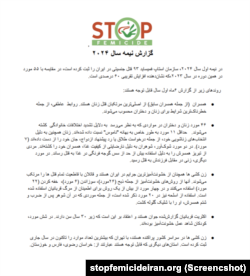
[ad_1]
Data from a specialized platform on gender-based murders in Iran show that in the first half of this year, the murder rate of women in Iran increased by 60% compared to the same period last year.
The Stop the Killing Iran platform, an organization focused on monitoring the murders of women in Iran, analyzed the number of these murders in 2023 and the first half of 2024 in an 18-month report on lethal violence against women and girls.
The report describes femicide as a “crime internationally recognized as one of the most horrific and neglected phenomena” and tracks and analyses the deliberate killing of women and girls in Iran.
Since four years ago, the platform has allowed users to access open data research on femicide in Iran through interactive maps.
The report stressed that femicides in Iran target “the lives of girls and women from all walks of life” and that these crimes are often committed by men in the family and occur “in both urban and rural areas and at all levels of socioeconomic status.”
The “Stop Femicide in Iran” platform highlights the need for “raising awareness, support and action to address the main causes of femicide and protect women’s lives from these tragedies.”
“There is a need to come together to raise awareness,” said Marjan Kipur, human rights activist and head of Stop Femicide in Iran. “Let’s fight for justice and finally stop the cycle of violence against women and girls. Every life lost to gender-based murder is a tragedy that should not go unaddressed. We must dismantle the harmful cultural norms and patriarchal systems that perpetuate this violence and build a society where all women can live without fear.”
The organization analyzed 156 gender-based murders recorded in 2023 and found that “factors such as increased government censorship, especially online, and a lack of public reporting by affected families due to a lack of trust in the government” led to the murders.
In addition, analysis of the age distribution of victims showed that “43% of the victims were young people”, “the age range was between 15 and 35 years old”, and “people of all ages were affected by gender-based murders.”
According to the report, the highest number of gender-based murders was recorded in Tehran, an area that is ethnically, socially and economically diverse.
Furthermore, “the available data do not reveal any information about the background of the victims, making it impossible to draw definitive conclusions about the dependence of femicide on race or socioeconomic status.”
According to the report, most murderers of women are “male members of the family, especially husbands,” with many of the murders taking place “for family reasons” and so-called “honor.”
The report also stressed that “femicide does not exclude children,” that in “almost 10%” of these murders, “young girls were direct victims,” and that “12 of the gender-based murders included victims who were married to their husbands before the children died. “They were forced.”
In the first half of 2024, the platform recorded “93 gender-based murders in Iran,” an “increase of about 60% compared to 55 cases in the same period last year.”
Emphasizing that the Islamic Republic wants to accept its incomplete narrative about the killing rate of women, Ms. Kipur had previously said in an interview with VOA that “the Islamic Republic does not want the world to realize the terrible situation in the country.” He reported the statistic and tried to keep the word in his hands.
The human rights researcher also stressed that “the Islamic Republic’s statistical methods and their reflection in the media under the supervision of the Islamic Republic are not something that can be counted on and regarded as reality.”
[ad_2]
Source link



